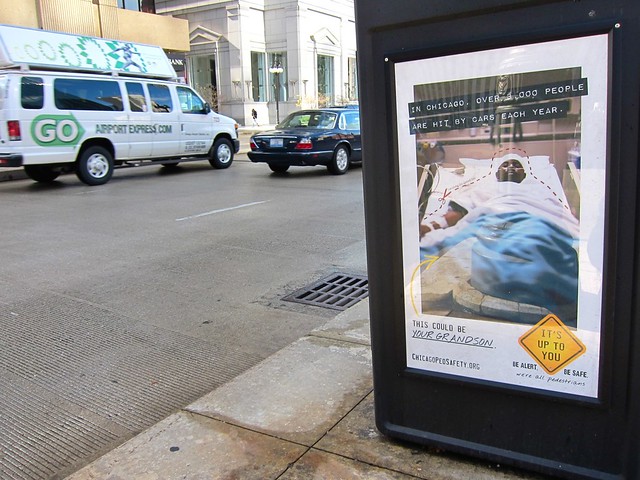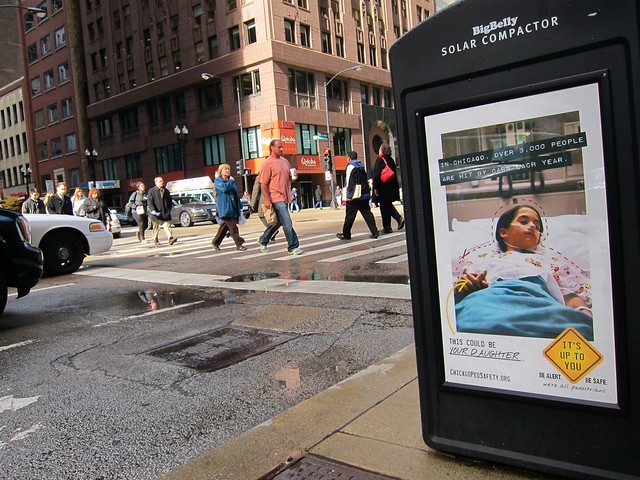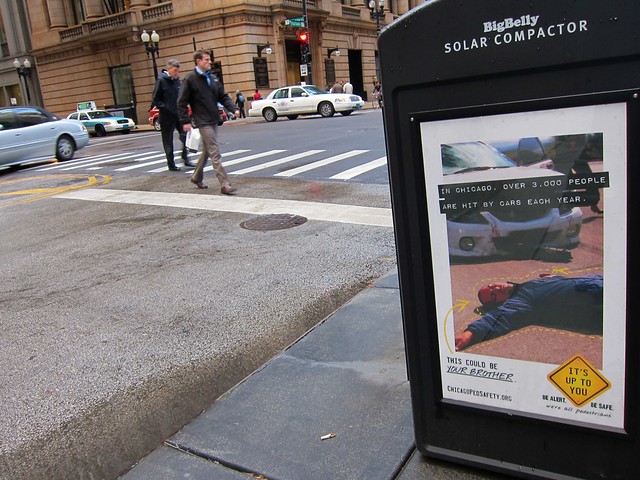Editor’s note: Michelle Stenzel is a co-leader of the North Side planning district in the Streets for Cycling 2020 Plan and co-chair of Bike Walk Lincoln Park, a committee to make walking and cycling safe in that neighborhood. All photos feature ads in the campaign and were taken by Stenzel. -Steven
The posters began popping up in the Loop last year in October, around the same time the mannequins appeared on Wacker Drive. Most of them have pictures of pedestrians who were seriously injured or killed in a crash. Not real victims, of course, actors presumably, but the photographs are graphic. The people are lying unconscious in hospital beds, with neck braces, head bandages, facial lacerations, and IV tubes. One poster shows a crash occurring from a viewpoint within the car, with the driver’s head hitting the steering wheel and the victim’s body bouncing off the shattered windshield. Another shows a dead man, still sprawled on the street where he was killed.
The accompanying text says things like, “This could be your brother.” “This could be your best friend.” “In Chicago, over 3,000 people are hit by cars each year.” “Hit a pedestrian and your car becomes more than a vehicle.”
You can see all the posters on the city’s pedestrian safety campaign website.
When I first saw these, I had mixed reactions. I was glad that the important issue of pedestrian safety had finally been brought to the forefront enough to warrant its own public service announcement campaign. The number of people walking in the city who are hit by cars is unacceptably high, and there are concrete actions that can be undertaken to reduce those numbers, like improving crosswalk design, and restricting right turns on red. Any effort to educate Chicagoans about the carnage that’s occurring, and perhaps prime them for why it’s important to spend funds to reduce the morbidity, is a step in the right direction.
However, my second reaction was repulsion. It’s jarring to see photographs of dead and injured people on the sides of trash cans while walking around the Loop during lunch hour. As a mother, I found it particularly difficult to look at the posters depicting children or teenagers.
Is the gore necessary? One can argue that the results of crashes involving motor vehicles and pedestrians are not pretty, so why not show people the ugly reality? The posters are certainly eye-catching, and probably have caused many people to read the accompanying messages, whereas a less-graphic photo wouldn’t have caught their attention.
On the other hand, the posters bring a visual and psychological ick factor to our streets. It’s simply not aesthetically optimal to have graphic photos like that everywhere: They’re not beautiful, uplifting, or inspiring, but are instead fear-inducing. After seeing them once, you don’t want to look at them again to absorb the negativity being broadcast. They send the message that Chicago is a dangerous place if, instead of driving, you dare to walk around – look what could happen to you!
You might even argue the posters discourage walking because they’re similar to the anti-smoking notices that feature graphic photos of people with oxygen tanks, diseased lungs and mouth cancer: You smoke -> Horrifying results occur -> Don’t smoke. You walk -> Horrifying results occur -> Don’t walk.
My third reaction was trying to figure out who the audience was. The posters seem to be limited mainly to the sides of trash/recycling bins on the sidewalk, and therefore most likely to be read by pedestrians. (The campaign’s website shows that the posters have been placed on the backs of CTA buses as well.) Yet, the messages seem to be targeted mostly at drivers: “Yield before turning at traffic signals.” “Drivers must stop for pedestrians entering the crosswalk.” Perhaps the thinking is that enough people who walk around the Loop also drive cars in the Loop or in their home neighborhoods, so the message is being absorbed by drivers.
A few of the posters are aimed squarely at pedestrians: “When crossing the street, be alert. Use crosswalks and obey all signals” and “Think before you cross”. Although sometimes pedestrians might contribute to a hazardous condition through inattention or risky moves, statistics reveal facts like in the central business district of Chicago, 60 percent of the pedestrians struck by vehicles were crossing at an intersection, with the signal, according to the 2011 Pedestrian Crash Analysis (.pdf) – turn to page 20 to see this statistic, and then see “key findings” on page 6.
Therefore, it doesn’t hurt to remind people who are walking to avoid distractions, cross with the light, and so on, but anything beyond that would sound like blaming the victim. People driving cars weighing 4,000 pounds have the most potential to cause harm to others, and they absolutely have the greatest responsibility to make sure they don’t hit a human being who is in front of them. Full stop.
So in the end, kudos to CDOT for raising awareness and starting the conversation. The posters have undoubtedly made many people think about the issue, perhaps for the first time. For the next campaign (promoting bicycling as transportation? or the availability of bike sharing?) though, I hope they choose a more positive focus.
What do you think of the campaign?



These aren’t easy to look at, but I think the idea of trying to personalize it could reach more people. I’ll be curious to see if there’s a noticeable difference in driver and ped behavior.
Perhaps the thinking is that enough people who walk around the Loop also
drive cars in the Loop or in their home neighborhoods, so the message
is being absorbed by drivers.
I think that’s exactly the idea. Most of the people walking around in the Loop do drive at other times, whether it’s in the Loop, in other Chicago neighborhoods, or in the suburbs.
While a high percentage of pedestrian crashes involve turning vehicles at intersections, jaywalking also contributes to ped crashes. I was riding my bike in the Loop the other day and had 3 near misses in 10 minutes with peds who popped out mid-block from between parked vehicles – without looking for traffic. I see this kind of behavior pretty much every time I’m walking or riding in the Loop.
I admit that I do jaywalk if I’m running late, but I’ll only do it – after looking both ways – if there is NO approaching traffic close enough to hit me. I have no intention of endangering myself or other people in doing it.
As I’m sure you’ve read in the book Traffic, Anna, people completely change their mindset, attitude, and level of awareness when they get in an automobile and start driving.
It’s because of this that I don’t think drivers will notice and pay attention to messages that are only slightly directed at them. A large billboard and comments/ads on the radio will better reach people who become the more dangerous component in a collision with someone walking.
This campaign really bothers me on so many levels. I didn’t like the mannequins in body bags at the El stops because as a pedestrian, I KNOW that I can get hit by a car at any time. I try really hard not to walk where I should, but car still honk at me when I’m in a cross walk, or last weekend at the grocery store, I almost got hit by a car right in front of the door of the store. So the reminder that I can be in a terrible accident at any time, with a really depressing visual? It doesn’t get me excited about safety: it makes me worry about dying at any moment.
It’s also another example of images that, if I had children, I really wouldn’t want them to see. I can explain to a kid “watch out for cars because they will hurt you” and I will supervise children if I had them with me. But I don’t think that’s necessary for them to see. How are you supposed to explain why that man is lying in the road in that picture, or what those fake people (mannequins) are standing in? Yes, they show much worse things on the news, but that’s a whole other issue.
I also feel like these PSA’s are not being placed correctly, because, while people who take the El/work in the Loop may also drive sometimes, this isn’t effective enough to get through to drivers on the road. Putting posters on the side of garbage cans is not going to get anyone’s attention except for the people walking and looking down, and that’s just maybe. And the statistics show that the rates for these accidents has gone down, but what other efforts are being taken? Even placing ads at eye-level to drivers could create more distraction. The pictures are a bit too graphic I think, though, even though there is reality to it.
I think the city’s heart is in the right place, but the execution leaves a lot to be desired.
Wow, I didn’t know they had mannequins in body bags — that’s even worse. The posters are graphic enough; not sure we need 3D representations.
I agree it’s unnecessary for kids to see these posters, and although they theoretically could serve as “teachable moments”, the final message is negative, grounded in fear, and I don’t support that style of communication.
I suppose the posters depicting kids affected me most because you can teach your children safety skills and supervise them, and do everything right, but it just takes one driver blowing a red light for everything to come to a horrible end for the person walking, even if he or she followed all “the rules”. It’s depressing to be reminded of this reality daily as I walk around the Loop.
I wonder what message this mannequin I spotted at the Belmont Blue Line was sending…
http://www.flickr.com/photos/jamesbondsv/6682908945/
Okay, it was probably just damaged. But transit riders are not the correct audience.
I saw similar displays at a few other CTA stations in the last week, although they were better placed than this one.
As you mentioned earlier, a person’s mindset does tend to change when they are driving a car. My own experience has been consistent with what was discussed in Traffic: the powerful isolating effect of being behind the wheel, encased in a moving bubble, which can override any sensitivity and conscience that might govern face-to-face encounters with strangers.
The question is whether any of the ped- and transit rider-oriented messages with stay with them while they’re driving, in spite of that isolating “bubble” effect. I think the shock is intended to linger, but I don’t know if that will be enough to overcome the “bubble.”
Unfortunately, I think there’s a huge swath of the greater Chicago population who are very frequent drivers, but are very rarely pedestrians, and therefore, they don’t feel the same reaction when they see the posters. (You know the old adage that a pedestrian in the suburbs is someone who is walking to his car.). So someone who drives a lot but walks very little might see those posters when they’re in the Loop, and think, “Thank God I don’t expose myself often to the dangers of walking” instead of thinking “Maybe I should drive more carefully to avoid hitting someone”.
I hadn’t heard that adage! It’s a great response to “Everyone’s a pedestrian at some point”.
Yes, I know people who drive everywhere and whose idea of walking is the shortest distance across a mall parking lot. They tend to be the least conscious of pedestrians and cyclists, and I think they’re our biggest danger. This campaign is unlikely to reach them at all.
I think a bunch of us (myself, Michelle, and some other readers who’ve left comments) are just impatiently waiting for the next move from the City in this campaign. Is it going to be groundbreaking (for our city, at least), or just another token gesture?
The real campaign should be to make cell phone use, hands free too, as much of evil as drunk driving. I see tons of drivers who in addition to having a different mindset when behind the are completely distracted by a pointless and needless conversation on a toy phone. Don’t talk on the phone while driving. Period.
Yes, the importance of minimizing distractions would have been a good theme to use on at least some of the posters, given how many drivers still talk on the cell phone, in blatant violation of the law.
Good point. Perhaps they could add a variant like “looking away for a few seconds to dial your phone could cause this.” I’d love to see more enforcement on the cell phone law. At certain times of day, some of the worst offenders in my neighborhood are parents who are talking on the phone – and arguing with their kids in the car at the same time – even worse because so many of them are driving behemoth SUVs and minivans.
Perhaps the $495,000 grant used for this campaign could have been better spent to employ Chicago Police to enforce the Illinois state law requiring automobiles to stop for pedestrians in crosswalks. How many intersections could be patrolled for a week to warn motorists that they will be ticketed for breaking the law? Tickets, fines, and continued enforcement will change motorist behavior. It just begs the question, is this really what Chicago wants or is it a well-intentioned department (CDOT) up against a stubborn city council and an underfunded police department.
In the meantime, motorists can continue to be pleasured by heat, leather seats, sexy H&M billboards, and the peace of mind knowing they are the biggest thing on the road.
Automobile crashes and our carnage culture are another reason to promote transit.
I have mixed feelings, working in advertising research I understand that the goal of advertising is to impact people’s opinions and/or behaviors — not to beautify the city. However there is a longstanding debate about the effectiveness of “scare tactics” advertising and how much is too much.
I acknowledge that the message really makes me think, more so than just saying “be careful” etc. Everyone *thinks* they’re being careful, right?
However perhaps the message could have gotten through by showing an ambulance or something not *quite* as disturbing as a little girl in a coma etc.
I think knowing the fact about 3000 people being hit helps me be more conscious about it, so the basic premise of the campaign seems good.